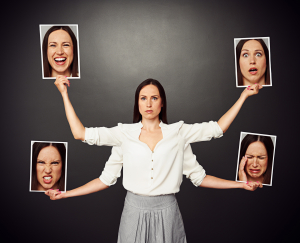
Did you get up on the wrong side of the bed? Years ago that expression meant that the person was grouchy, irritable or in a bad mood.
People can tell if you are in a bad mood. We communicate our emotions to others and they are able to tell what kind of a mood we’re in. In fact that may be one of the main reasons for emotions.
Charles Darwin believed that body movements and facial expressions of emotions are used by members of a species to communicate meaning, as well. Humans aren’t the only sentient beings, and we certainly aren’t the only ones to communicate happiness, pain, or fear.
What we learned quickly as children about the meaning of emotions is that there are good emotions and there are bad emotions. We are only allowed to have and express “good” emotions and we must deny or hide the “bad” emotions.
Really? Emotions just are. They are neither good nor bad and denying or hiding them can make you sick … which is exactly why they are an important element of wellness.
Proceeding with the series of blogs on Wellness, this post will continue with the spin around the wellness wheel focusing on the 12 dimensions of wellness. This week we are landing on the dimension of feelings.
What Does Research Say About Emotions?
There has been an enormous body of research about our emotions and feelings. Psychologists have debated about the function of our emotions, the number of our emotions, how we express them, the cultural component , how they affect our brain etc, etc, etc.
Many of these theorists proposed that there are only six major emotions and that all other emotions are secondary emotions that are a variation of the major six.
EMOTION FUNCTION FUNCTIONAL DESCRIPTION
Fear Protection Designates danger
Anger Destruction Eliminates barriers to satisfaction
Disgust Rejection Rooted in need to expel something harmful
Sadness Reintegration Request for support
Joy Incorporation Supports involvement in the community
Surprise Orientation Signal to proceed with caution
The more complex variations of emotions have evolved from these foundational building blocks and, like a color spectrum, involve a great deal of variation.
Opening Yourself Up to Emotions
In order to be fully alive and vital we have to open ourselves up to the full spectrum of emotions – the ones that feel terrific and the ones that feel difficult.
Emotions are like a ying and a yang. If you don’t feel sadness then you can’t feel joy. If you don’t feel angry then you can’t feel happy, and so on and so forth.
When we cut ourselves off from one emotion we are cutting ourselves off from all emotions. We become numb.
Therefore, being open to all emotions and dealing with them effectively is a cornerstone of wellness. What does it mean to deal with them effectively?
A mentor used to give me the sage advice “Don’t just do something – sit there.” The point is that sometimes you just have to “sit with” your emotions. You have to become aware of them.
Becoming emotionally aware means following a sequence of observing our internal process:
- Something happened – what am I feeling?
- Can I give the feeling a name?
- Where in my body am I noticing a sensation associated with this feeling?
- Can I just sit with it and allow myself to feel?
- Is there something I want to do about it?
What If Emotions Weren’t Good or Bad?
Many of our feelings can be rooted in the way we were taught to behave as children. Things that we were asked to repress, and/or the way our parents acted all contribute to how we react to our emotions as adults.
When you sit with your emotions, you open yourself to begin to take responsibility for how you are feeling. You give yourself the opportunity to make a choice as to what you’ll do next, if anything.
In this blog, you should begin to recognize that emotions just are – they are not good or bad. We have to be open to all emotions and if we suppress uncomfortable emotions we pay the price with our health – a concept that is explained much more substantially in the Wellness Inventory.
 Dr. Ines K. Roe has been helping women in transition rediscover themselves for over 20 years. If you’ve been feeling unfulfilled, are frustrated with your sense of accomplishment in midlife, or simply need guidance on your path to holistic well being, contact Ines and schedule a complimentary session or consider her ecourses, if you are looking for an unaccompanied path.
Dr. Ines K. Roe has been helping women in transition rediscover themselves for over 20 years. If you’ve been feeling unfulfilled, are frustrated with your sense of accomplishment in midlife, or simply need guidance on your path to holistic well being, contact Ines and schedule a complimentary session or consider her ecourses, if you are looking for an unaccompanied path.

Such valuable information! I will be using those questions to help me become more “emotionally aware.”
This kind of mindful thinking is so useful! Unfortunately, those of us who really SHOULD read this post, won’t. Good food for thought….and action!
Don’t worry….I am very mindful of my emotions. I have always been deeply feeling…sometimes I envy those who don’t seem to “feel” as acutely. I think it is a blessing and a curse.
Owner of a wicked Irish temper here. I work very hard to own my emotions and understand my triggers. Thx a bunch for the savvy advice!
Thought-provoking. So where does Contentment fit into that 6 emotion line up? I’m a placid person who rarely feels fear, anger or disgust. But I’m usually contented.
This is a very interesting read and such great information! I’m a very passionate person, so it feels like all emotions are running through me at any given moment!
Hmmm… very thought provoking. As far as joy is concerned, I see joy as a sense of thankfulness, to some degree. Thankfulness for the moment, the gifts of life. I’m not very community oriented, so I would never consider joy and community related. I find more joy in solitude, to be honest.
I’ll be thinking on this for quite some time. Thank you!
What a lovely and thought-provoking post. Thanks for sharing it.